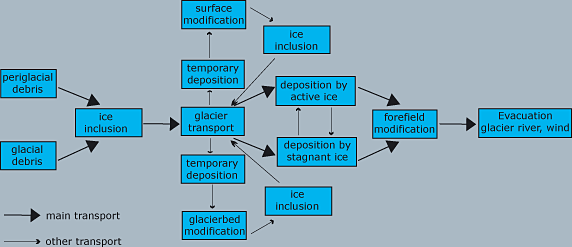 |
|
|
|
|
|
|
Overall processes of glacier erosion and sedimentation are governed by
|

1 - Scheme of a debris transport system by a glacier (after Sugden and John 1977) |
The simplicity of such an approach only allows for rough assessments concerning glacier bed characteristics as tested with observations in glacier forefields exposed during 20th-century glacier shrinkage. However, this simplified approach, clearly illustrates that a combination of factors must be taken into account and that the entire system with its input, throughput and output should be considered. It is difficult to measure the sediment balance of a glacierized catchment, i.e., the ratio between debris input from the surrounding rock walls and debris evacuation by the meltwater stream, can hardly be measured directly (Figure 2, interactive). The main factors, however, influencing the governing processes, however, can be organized in the form of an index (Ies) of glacier erosion and sedimentation, which discriminates between glaciers eroding into bedrock and those building up thick sediment beds: |
|
|
| Use the animated erosion-sedimentation index (figure 2) to experience the influence of the different Ies-parameters on the glacial sediment balance! |
|
Animation concept: Michael Zemp |
| 1) As a little sensitivity experiment, check the influence of each parameter on the glacial sediment balance, leaving all other parameters on their standard position (“middle”)! What is the reaction of the glacial sediment balance to a change of its individual parameters? What is the physical meaning, the related process behind this reaction? |
| 2) According to the erosion-sedimentation index, which glaciers build up thick sedimentary beds and which erode into their bedrock? Which parameter combinations produce this two extremes of the glacial sediment balance? 3) One last question for advanced Ies-users: according to the erosion-sedimentation index, what’s the influence of climate change on the glacial sediment balance? |
|
3 - Dom-Taeschorn-area, Mattertal, Valais, Switzerland.
|
The friction developed by sliding causes abrasion at the base of temperate glaciers or glacier parts appears to reinforce the influence of the sediment balance in the catchment. The degree of sliding is inversely related to sediment concentrations in the basal ice layer. With high sediment concentrations ("sandpaper friction, sliding can be limited to short time periods of extremely high subglacial water pressure and, hence, overall amounts of abrasion can decrease to zero or even change into sedimentation. This concept suggests that debris-laden glaciers show a "stop-and-go" sliding behaviour and tend to build up sediment beds, whereas glaciers receiving less debris from the surrounding mountains slide more continuously and tend to erode into bedrock. |
29 August 2011 |
||
| |
||
